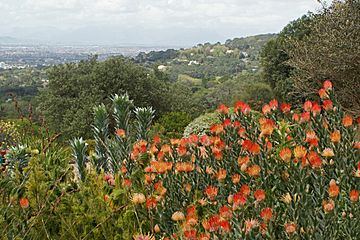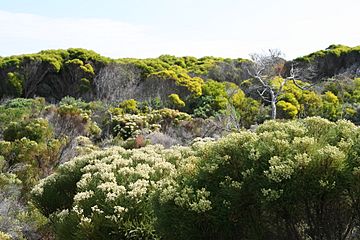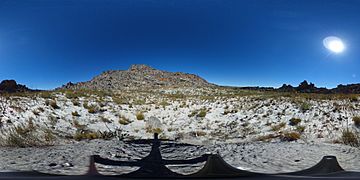Cape Floristic Region facts for kids
| UNESCO World Heritage Site | |
|---|---|
 |
|
| Location | South Africa |
| Includes |
|
| Criteria | Natural: (ix), (x) |
| Inscription | 2004 (28th Session) |
| Extensions | 2015 |
| Area | 1,094,742 ha (2,705,170 acres) |
| Buffer zone | 798,514 ha (1,973,170 acres) |


The Cape Floristic Region is a special area for plants in South Africa. It is found near the southern tip of the country. This region is the only one of its kind in the Cape Floristic Kingdom. It has just one plant province, called the Cape Floristic Province.
This region is the smallest of the world's six main plant kingdoms. But it has an amazing number of different plant species. Over 9,000 types of plants grow here. About 69 percent of these plants are endemic, meaning they are found nowhere else. Much of this plant variety comes from the fynbos biome. Fynbos is a type of shrubland that often has fires. It grows in areas with a Mediterranean-like climate.
The fynbos plants are valuable. People harvest wildflowers and other products from them. Eco-tourism, which means visiting nature, also brings money to the area. This shows that the Cape Floristic Region is important for both its plants and its economy. It is a "biodiversity hotspot," meaning it has many unique living things.
Contents
Where is the Cape Floristic Region?
This region has the most plant species outside of tropical areas. It is the only "biodiversity hotspot" that covers an entire plant kingdom. Five of South Africa's 12 plant families that are found only there live here. It also has 160 plant groups (genera) found nowhere else.
The Cape Floristic Region covers about 78,555 square kilometers. It is completely inside South Africa. This area is one of five Mediterranean-type climate systems on the hotspot list. It is also one of only two hotspots that include a whole plant kingdom. The other is New Caledonia.
The region is in the Western Cape of South Africa. This is in the southwestern part of the country. It stretches east into the Eastern Cape. This eastern part is a mix of areas with winter rain and summer rain.
What Plants Grow in the Cape Floristic Region?
Most of the Cape Floristic Region is covered with fynbos. Fynbos plants have hard, leathery leaves. They grow in sandy or poor soils from the Table Mountain sandstones. Fynbos is home to many different plant species. These include members of the protea family (Proteaceae), heath family (Ericaceae), and reed family (Restionaceae).
Other types of plants also grow here. Sandveld is a soft coastal scrubland. It is mostly found on the west coast of the Western Cape. It grows on younger sandy soils. Renosterveld is a grassy shrubland. It is mostly made up of plants from the daisy family (Asteraceae). A common plant here is the renosterbos (Elytropappus rhinocerotis). Renosterveld grows on richer, shaley soils near the coast.
Small areas of Afromontane forest can also be found. These are in humid and sheltered places.
Why is the Cape Floristic Region Important?
The World Wide Fund for Nature (WWF) has divided the Cape Floristic Region into three main natural areas. These are the Lowland fynbos and renosterveld, Montane fynbos and renosterveld, and the Albany thickets.
The fynbos areas are considered very important for conservation. They are part of the "Global 200" priority areas. Conservation International has also called the Cape Floristic Region a "biodiversity hotspot." This means it is a very important place for many different kinds of life.
Sadly, the Cape Floristic Region is losing plants faster than many other places. This is happening because of several reasons. Habitats are being destroyed, meaning plants are losing their homes. The land is also being damaged. And new plants that are not from this area, called invasive alien plants, are taking over.
Cape Floral Region: A World Heritage Site

In 2004, the "Cape Floral Region Protected Areas" became a World Heritage Site. This means it is a place of special importance to all of humanity. The site includes eight protected areas. These areas help to save the unique plants and animals of the region.
The protected areas are:
- Table Mountain National Park
- Cederberg Wilderness Area
- Groot Winterhoek Wilderness Area
- Boland Mountain Complex (which includes Limietberg, Jonkershoek, Assegaaibosch, Hottentots Holland, and Kogelberg Nature Reserves)
- De Hoop Nature Reserve
- Boosmansbos Wilderness Area
- Swartberg Complex (including Swartberg, Gamkapoort, and Towerkop Nature Reserves)
- Baviaanskloof Mega Reserve
See also
 In Spanish: %C3%81reas protegidas de la Regi%C3%B3n Floral del Cabo para ni%C3%B1os
In Spanish: %C3%81reas protegidas de la Regi%C3%B3n Floral del Cabo para ni%C3%B1os

